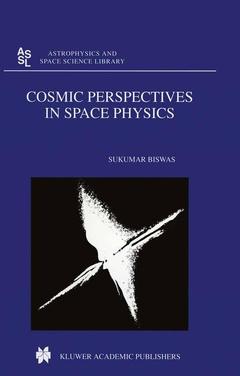Description
Cosmic Perspectives in Space Physics, 1999
Astrophysics and Space Science Library Series, Vol. 242
Author: Biswas S.
Language: English
Subject for Cosmic Perspectives in Space Physics:
Cosmic Perspectives in Space Physics
Publication date: 10-2012
495 p. · 16x24 cm · Paperback
Publication date: 10-2012
495 p. · 16x24 cm · Paperback
Approximative price 210.99 €
Subject to availability at the publisher.
Add to cart
Cosmic perspectives in space physics
Publication date: 06-2000
495 p. · 17x24.4 cm · Hardback
Publication date: 06-2000
495 p. · 17x24.4 cm · Hardback
Description
/li>Contents
/li>
In the early years of the twentieth century, Victor Hess of Germany flew instruments in balloons and so discovered in 1912 that an extra-~errestial radiation of unknown origin is incident on the earth with an almost constant intensity at all times. These penetrating non solar radiations which were called Cosmic Rays by Millikan, USA, opened the new frontier of space physics and many leading scientists were attracted to it. At the end of World War II a number of space vehicles, e.g. stratospheric balloons, rockets and satellites were developed. In 1950 and onwards, these vehicles enabled spectacular advances in space physics and space astrophysics. New horizons were opened in the explorations of cosmic rays, the earth's magnetosphere, the Sun and the heliosphere, the moon and the planets. Using space-borne instruments, exciting discoveries were made of stars, and galaxies in the infra-red, ultra violet, x-ray and gamma-ray wavelengths. In this text book these fascinating new findings are presented in depth and on a level suitable for senior undergraduate and graduate students, research scientists and scientists of other disciplines. Although there are several excellent books and monographs on different aspects, most of these deal with specific areas. In this text book the findings of space physics and astrophysics are presented in an integrated manner with proper introductions to the fundamental aspects, and these are supplemented by relevant ground based observations.
1 Introduction to Space Research.- 1.1 Early History of Space Physics.- 1.2 The New Space Age and Global Plans.- 1.3 Space Vehicles and Space Physics.- 1.4 Problems on Chapter 1.- 2 The Magnetosphere of the Earth.- 2.1 Early Concepts.- 2.2 Experimental Methods in Space Studies and Observations.- 2.3 The Structure of the Magnetosphere.- 2.4 Motion of Charged Particles in the Magnetosphere.- 2.5 The Radiation Belts of the Earth.- 2.6 Heavy Ions in the Magnetosphere of the Earth.- 2.7 Problems on Chapter 2.- 3 The Sun and the Heliosphere.- 3.1 The Sun and Space Astrophysics.- 3.2 Sunspots and the Solar Cycles.- 3.3 Solar Wind.- 3.4 Solar and Interplanetary Magnetic Fields.- 3.5 The Active Sun.- 3.6 The Outer Heliosphere.- 3.7 Problems on Chapter 3.- 4 The Moon and the Planets.- 4.1 The Moon.- 4.2 Space Missions and Planetary Exploration.- 4.3 Inner Planets.- 4.4 The Asteroid Belt.- 4.5 Outer Planets.- 4.6 Problems on Chapter 4.- 5 Comets, Meteorites and the origin of the Solar System.- 5.1 Comets and Cometary Probes.- 5.2 The Oort Cloud and the Origin of Comets.- 5.3 Meteorites.- 5.4 Interplanetary Dust.- 5.5 The Origin and Early History of the Solar System.- 5.6 Problems on Chapter 5.- 6 Solar Energetic Particles.- 6.1 General Features and Early Observations.- 6.2 Observational Methods and Early Results.- 6.3 Properties of Energetic Solar Particles.- 6.4 Coronal and Interplanetary Propagation of SEP.- 6.5 Solar Energetic Particles in the Distant Past.- 6.6 Acceleration of Particles in the Sun.- 6.7 Problems on Chapter 6.- 7 Galactic Cosmic Rays.- 7.1 Early Studies and General Features.- 7.2 Interactions of Cosmic Rays with Matter.- 7.3 Methods of Studies of Cosmic Ray Nuclei.- 7.4 Properties of Cosmic Rays and their Implications.- 7.5 Cosmic Ray Propagation in Interplanetary Space.- 7.6 Cosmic Ray Propagation in Interstellar Space.- 7.7 Origin of Cosmic Rays.- 7.8 Problems on Chapter 7.- 8 Space Astrophysics.- 8.1 New Astrophysics from Space Observatories.- 8.2 New Windows to the Universe.- 8.3 Cosmology from Space.- 8.4 Problems on Chapter 8.- 9 The Interstellar Medium (ISM).- 9.1 General Features.- 9.2 Large Scale Dynamical Processes.- 9.3 Physical Features of the ISM.- 9.4 Interstellar Dust.- 9.5 Interstellar Molecules.- 9.6 Organic Molecules in Large Molecular Clouds.- 9.7 The Origin of Life: Terrestrial vs Extra Terrestrial.- 9.8 Problems on Chapter 9.- 10 Concluding Remarks.- References.
© 2024 LAVOISIER S.A.S.




